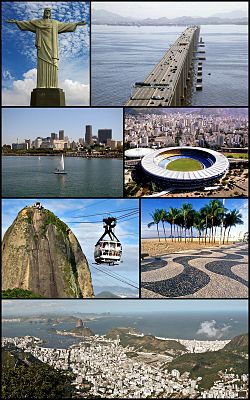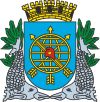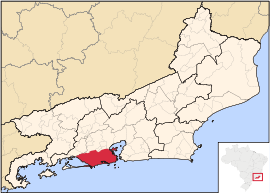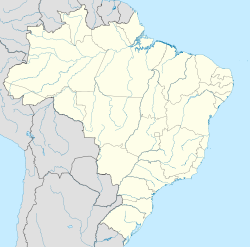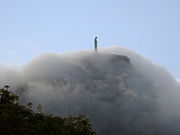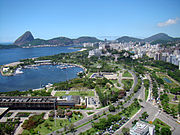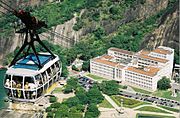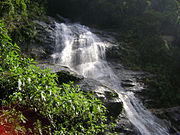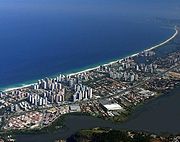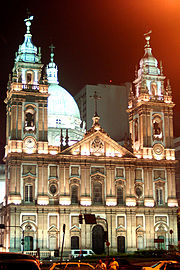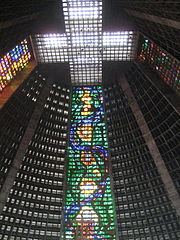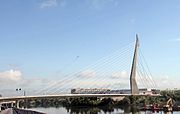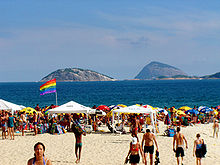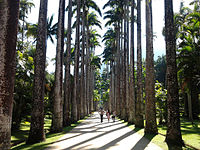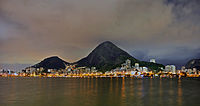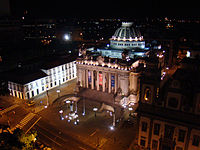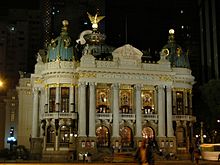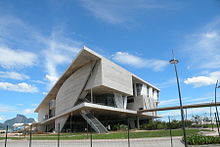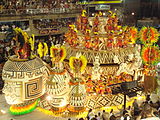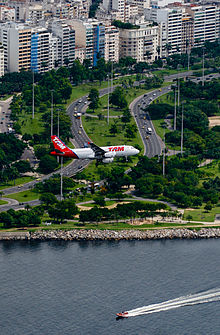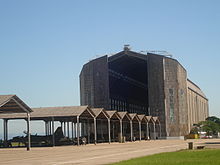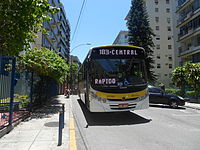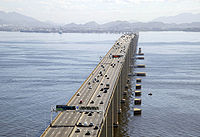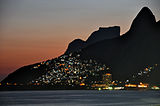
Rio de Janeiro
Did you know...
This selection is made for schools by a children's charity read more. SOS Children has looked after children in Africa for forty years. Can you help their work in Africa?
| Rio de Janeiro | |||
|---|---|---|---|
| — Municipality — | |||
| Município do Rio de Janeiro Municipality of Rio de Janeiro |
|||
| From the top to right: Christ the Redeemer, Rio–Niterói bridge, Centro, Maracanã Stadium, Sugarloaf Mountain, Copacabana Beach, and panorama of the city taken from Corcovado. | |||
|
|||
| Localization in Rio de Janeiro | |||
|
|
|||
| Coordinates: 22°54′30″S 43°11′47″W Coordinates: 22°54′30″S 43°11′47″W | |||
| Country | |||
| Region | Southeast | ||
| State | |||
| Founded | March 1, 1565 | ||
| Government | |||
| • Type | Mayor-council | ||
| • Body | Prefeitura da Cidade do Rio de Janeiro | ||
| • Mayor | Eduardo Paes ( PMDB (2013–2016)) | ||
| Area | |||
| • Municipality | 1,260 km2 (486.5 sq mi) | ||
| • Metro | 4,557 km2 (1,759.6 sq mi) | ||
| Elevation | from 0 to 1,021 m (from 0 to 3,349 ft) | ||
| Population (2010) | |||
| • Municipality | 6,323,037 | ||
| • Rank | 2nd | ||
| • Density | 4,781/km2 (12,380/sq mi) | ||
| • Metro | 12,387,000 | ||
| Demonym | Carioca | ||
| Time zone | BRT ( UTC−3) | ||
| • Summer ( DST) | BRST ( UTC−2) | ||
| Postal Code | 20000-000 | ||
| Area code(s) | +55 21 | ||
| Website | www.rio.rj.gov.br | ||
| Type: | Cultural | ||
| Criteria: | vi | ||
| Designated: | 2012 (36th session) | ||
| Reference No. | 1100 | ||
| State Party: | Brazil | ||
| Region: | Latin America and the Caribbean | ||
Rio de Janeiro (pron.: / ˈ r iː oʊ d eɪ ʒ ə ˈ n ɛər oʊ / or / ˈ r iː oʊ d eɪ dʒ ə ˈ n ɛər oʊ /; Portuguese pronunciation: [ˈʁi.u dʒi ʒaˈnejɾu], January River), commonly referred to simply as Rio, is the capital city of the State of Rio de Janeiro, the second largest city of Brazil, and the third largest metropolitan area and agglomeration in South America, boasting approximately 6.3 million people within the city proper, making it the 6th largest in the Americas, and 26th in the world. Rio de Janeiro has become a home of a World Heritage Site named "Rio de Janeiro: Carioca Landscapes between the Mountain and the Sea", as granted by UNESCO on 1 July 2012 in the category Cultural Landscape.
The city was the capital of Brazil for nearly two centuries, from 1763 to 1815 during the Portuguese colonial era, 1815 to 1821 as the capital of the United Kingdom of Portugal, Brazil and Algarves, and 1822 to 1960 as an independent nation. Rio is nicknamed the Cidade Maravilhosa or "Marvelous City".
Rio de Janeiro represents the second largest GDP in the country (and 30th largest in the world in 2008), estimated at about R$343 billion (IBGE/2008) (nearly US$201 billion), and is headquarters to two of Brazil's major companies— Petrobras and Vale, and major oil companies and telephony in Brazil, besides the largest conglomerate of media and communications companies in Latin America, the Globo Organizations. The home of many universities and institutes, it is the second largest centre of research and development in Brazil, accounting for 17% of national scientific production—according to 2005 data.
Rio de Janeiro is one of the most visited cities in the southern hemisphere and is known for its natural settings, carnival celebrations, samba, Bossa Nova, balneario beaches such as Barra da Tijuca, Copacabana, Ipanema, and Leblon. Some of the most famous landmarks in addition to the beaches include the giant statue of Christ the Redeemer ("Cristo Redentor") atop Corcovado mountain, named one of the New Seven Wonders of the World; Sugarloaf mountain (Pão de Açúcar) with its cable car; the Sambódromo, a permanent grandstand-lined parade avenue which is used during Carnival; and Maracanã Stadium, one of the world's largest football stadiums.
The 2016 Summer Olympics and the Paralympics will take place in Rio de Janeiro, which will mark the first time a South American or a Portuguese-speaking nation hosts the event. It will be the third time the Olympics will be held in a Southern Hemisphere city, and it will mean Australia will no longer be the only Southern Hemisphere country to have hosted the Olympics. On 12 August 2012, at the 2012 Summer Olympics closing ceremony, Mayor Eduardo Paes received the Olympic Flag, via Jacques Rogge, from London Mayor Boris Johnson. Rio's Maracanã Stadium also held the final of the 1950 FIFA World Cup which Brazil's first streak to host and will host again the final match of the 2014 FIFA World Cup. Rio de Janeiro will also host World Youth Day in 2013.
Geography
Rio de Janeiro is on a strip of Brazil's Atlantic coast, close to the Tropic of Capricorn, where the shoreline is oriented east–west. Facing largely south, the city was founded on an inlet of this stretch of the coast, Guanabara Bay (Baía de Guanabara), and its entrance is marked by a point of land called Sugar Loaf (Pão de Açúcar)—a "calling card" of the city.
The Centre ( Centro), the core of Rio, lies on the plains of the western shore of Guanabara Bay. The greater portion of the city, commonly referred to as the North Zone (Zona Norte), extends to the northwest on plains composed of marine and continental sediments and on hills and several rocky mountains. The South Zone (Zona Sul) of the city, reaching the beaches fringing the open sea, is cut off from the Centre and from the North Zone by coastal mountains. These mountains and hills are offshoots of the Serra do Mar to the northwest, the ancient gneiss-granite mountain chain that forms the southern slopes of the Brazilian Highlands. The large West Zone (Zona Oeste), long cut off by the mountainous terrain, had been made accessible by new roads and tunnels by the end of the 20th century.
The population of the city of Rio de Janeiro, occupying an area of 1,182.3 square kilometres (456.5 sq mi), is about 6,000,000. The population of the greater metropolitan area is estimated at 11–13.5 million. It was Brazil's capital until 1960, when Brasília took its place. Residents of the city are known as cariocas. The official song of Rio is "Cidade Maravilhosa", by composer André Filho.
Climate
Rio has a tropical savanna climate that closely borders a tropical monsoon climate according to the Köppen climate classification, and is often characterized by long periods of heavy rain from December to March. In inland areas of the city, temperatures above 40 °C (104 °F) are common during the summer, though rarely for long periods, while maximum temperatures above 27 °C (81 °F) can occur on a monthly basis.
Along the coast, the breeze, blowing alternately onshore and offshore, moderates the temperature. Because of its geographic situation, the city is often reached, especially during autumn and winter, by cold fronts advancing from Antarctica, causing frequent weather changes. It is mostly in summer that strong showers provoke catastrophic floods and landslides. The mountainous areas register greater rainfall since they constitute a barrier to the humid wind that comes from the Atlantic.
It is said that the city had frost in its past, but it was never confirmed. Some areas within Rio de Janeiro state have snow grains and ice pellets with an even frequency (popularly called granizo, or "hail", although it is in fact melted and refrozen snow falling in the form of a ball—true hail, rather than just icy snow along showers, is much less common). These phenomena are definitely not rare or limited to a few regions, happening in the metropolitan area (including western suburbs of the city itself) at least three times in the 21st century, said to be approximately each two decades or less in some regions. In other areas there is true snowfall more than once in each century, most commonly in the cities of Resende and Itatiaia (in lower latitudes than Rio de Janeiro, but much higher altitudes).
Roughly in the same suburbs corresponding to the March 2012 and February–March 2013 granizo falls ( Nova Iguaçu and surrounding areas, including parts of Campo Grande), there was a tornado-like phenomenum in January 2011, for the first time in the region's recorded history, causing structural damage and lasting blackouts, but no fatalities. The World Meteorological Organization alerts Brazil, specially its Southeastern region, that events as the catastrophic January 2011 Rio de Janeiro floods and mudslides are not an isolated phenomenum and that Brazil must be prepared for severe weather in the next years. "This (the early 2010s serial devastation in Rio de Janeiro's mesoregions Metropolitana do Rio de Janeiro and Sul Fluminense) was not an isolated event. The events in Brazil confirms a global trend that storms tend to be increasingly strong and in places where it did not take place with the same force", said Rupakumar Kolli, WMO expert on climatological phenomena.
The average annual minimum temperature is 21 °C (70 °F), the average annual maximum temperature is 27 °C (81 °F), and the average annual temperature is 23 °C (73 °F). The average yearly precipitation is 1,175 mm. According to INMET, the minimum temperature recorded was 4.8 °C (41 °F) in July 1928, in the Campo dos Afonsos bairro (the Portuguese word for neighbourhood), and the absolute maximum was 44 °C (111 °F) in February. The lowest temperature ever registered in the 21st century was 8.1 °C (47 °F) in Vila Militar, July 2011. Temperatures below 10 °C (50 °F) are very rare in the city. The temperature varies according to elevation, distance from the coast, and type of vegetation. Winter brings mild temperatures and less rain than in the summer.
Average annual temperature of the sea is 23–24 °C (73–75 °F), from 22 °C (72 °F) in the period July–October to 26 °C (79 °F) in February and March. The wettest and driest months tend to be December and August respectively.
| Climate data for Rio de Janeiro | |||||||||||||
|---|---|---|---|---|---|---|---|---|---|---|---|---|---|
| Month | Jan | Feb | Mar | Apr | May | Jun | Jul | Aug | Sep | Oct | Nov | Dec | Year |
| Record high °C (°F) | 43 (109) |
42 (108) |
40 (104) |
40 (104) |
38 (100) |
37 (99) |
38 (100) |
42 (108) |
42 (108) |
42 (108) |
43 (109) |
43 (109) |
43 (109) |
| Average high °C (°F) | 29.4 (84.9) |
30.2 (86.4) |
29.4 (84.9) |
27.8 (82) |
26.4 (79.5) |
25.2 (77.4) |
25.3 (77.5) |
25.6 (78.1) |
25.0 (77) |
26.0 (78.8) |
27.4 (81.3) |
28.6 (83.5) |
27.2 (81) |
| Daily mean °C (°F) | 26.4 (79.5) |
26.7 (80.1) |
26.4 (79.5) |
24.9 (76.8) |
23.4 (74.1) |
22.0 (71.6) |
21.9 (71.4) |
22.3 (72.1) |
22.1 (71.8) |
23.1 (73.6) |
24.4 (75.9) |
25.5 (77.9) |
24.1 (75.4) |
| Average low °C (°F) | 23.3 (73.9) |
23.5 (74.3) |
23.3 (73.9) |
21.9 (71.4) |
20.4 (68.7) |
18.7 (65.7) |
18.4 (65.1) |
18.9 (66) |
19.2 (66.6) |
20.2 (68.4) |
21.4 (70.5) |
22.4 (72.3) |
21.0 (69.8) |
| Record low °C (°F) | 17 (63) |
17 (63) |
17 (63) |
15 (59) |
10 (50) |
7 (45) |
11 (52) |
10 (50) |
13 (55) |
12 (54) |
12 (54) |
17 (63) |
7 (45) |
| Precipitation mm (inches) | 114.1 (4.492) |
105.3 (4.146) |
103.3 (4.067) |
137.4 (5.409) |
85.6 (3.37) |
80.4 (3.165) |
56.4 (2.22) |
50.5 (1.988) |
87.1 (3.429) |
88.2 (3.472) |
95.6 (3.764) |
169.0 (6.654) |
1,172.9 (46.177) |
| Avg. precipitation days (≥ 0.1 mm) | 12 | 9 | 9 | 10 | 9 | 8 | 6 | 6 | 9 | 10 | 11 | 13 | 112 |
| % humidity | 73 | 72 | 75 | 77 | 76 | 74 | 73 | 73 | 75 | 74 | 73 | 74 | 74.1 |
| Mean monthly sunshine hours | 195.3 | 214.6 | 195.3 | 165.0 | 170.5 | 156.0 | 182.9 | 179.8 | 138.0 | 158.1 | 168.0 | 161.2 | 2,084.7 |
| Source #1: World Meteorological Organization (UN), Hong Kong Observatory | |||||||||||||
| Source #2: Weatherbase (record highs and lows, humidity) | |||||||||||||
| Jan | Feb | Mar | Apr | May | Jun | Jul | Aug | Sep | Oct | Nov | Dec | Year |
|---|---|---|---|---|---|---|---|---|---|---|---|---|
| 25 °C (77 °F) | 26 °C (79 °F) | 26 °C (79 °F) | 25 °C (77 °F) | 24 °C (75 °F) | 23 °C (73 °F) | 22 °C (72 °F) | 22 °C (72 °F) | 22 °C (72 °F) | 22 °C (72 °F) | 23 °C (73 °F) | 25 °C (77 °F) | 24 °C (75 °F) |
Cityscape
History
Europeans first encountered Guanabara Bay on January 1, 1502 (hence Rio de Janeiro, "January River"), by a Portuguese expedition under explorer Gaspar de Lemos captain of a ship in Pedro Álvares Cabral's fleet, or under Gonçalo Coelho. Allegedly the Florentine explorer Amerigo Vespucci participated as observer at the invitation of King Manuel I in the same expedition. The region of Rio was inhabited by the Tupi, Puri, Botocudo and Maxakalí peoples.
In 1555, one of the islands of Guanabara Bay, now called Villegagnon Island, was occupied by 500 French colonists under the French admiral Nicolas Durand de Villegaignon. Consequently, Villegagnon built Fort Coligny on the island when attempting to establish the France Antarctique colony.
The city of Rio de Janeiro proper was founded by the Portuguese on March 1, 1565 and was named São Sebastião do Rio de Janeiro, in honour of St. Sebastian, the saint who was the namesake and patron of the then Portuguese Monarch D. Sebastião. Rio de Janeiro was the name of Guanabara Bay. Until early in the 18th century, the city was threatened or invaded by several, mostly French, pirates and buccaneers, such as Jean-François Duclerc and René Duguay-Trouin.
In the late 17th century, still during the Sugar Era, the Bandeirantes found gold and diamonds in the neighboring captaincy of Minas Gerais, thus Rio de Janeiro became a much more practical port for exporting wealth (gold, precious stones, besides the sugar) than Salvador, Bahia, which is much farther to the northeast. And so in 1763, the colonial administration in Portuguese America was moved from Salvador to Rio de Janeiro. The city remained primarily a colonial capital until 1808, when the Portuguese royal family and most of the associated Lisbon nobles, fleeing from Napoleon's invasion of Portugal, moved to Rio de Janeiro. The kingdom's capital was transferred to the city, which, thus, became the only European capital outside of Europe. As there was no physical space or urban structure to accommodate hundreds of noblemen who arrived suddenly, many inhabitants were simply evicted from their homes. There was a large influx of African slaves to Rio de Janeiro: in 1819, there were 145,000 slaves in the captaincy. In 1840, the number of slaves reached 220,000 people.
When Prince Pedro I proclaimed the independence of Brazil in 1822, he decided to keep Rio de Janeiro as the capital of his new empire. Rio continued as the capital of Brazil after 1889, when the monarchy was replaced by a republic. Until the early years of the 20th century, the city was largely limited to the neighborhood now known as the historic Downtown business district (see below), on the mouth of Guanabara Bay. The city's centre of gravity began to shift south and west to the so-called Zona Sul (South Zone) in the early part of the 20th century, when the first tunnel was built under the mountains located between Botafogo and the neighbourhood now known as Copacabana. Expansion of the city to the north and south was facilitated by the consolidation and electrification of Rio's streetcar transit system after 1905. Botafogo's natural beauty, combined with the fame of the Copacabana Palace Hotel, the luxury hotel of the Americas in the 1930s, helped Rio to gain the reputation it still holds today as a beach party town (though, this reputation has been somewhat tarnished in recent years by favela violence resulting from the narcotics trade). Plans for moving the nation's capital city to the territorial centre had been occasionally discussed, and when Juscelino Kubitschek was elected president in 1955, it was partially on the strength of promises to build a new capital. Though many thought that it was just campaign rhetoric, Kubitschek managed to have Brasília built, at great cost, by 1960. On April 21 that year the capital of Brazil was officially moved from Rio de Janeiro to Brasília.
Between 1960 and 1975 Rio was a city-state under the name Guanabara State (after the bay it borders). However, for administrative and political reasons, a presidential decree known as "The Fusion" removed the city's federative status and merged it with the State of Rio de Janeiro, the territory surrounding the city whose capital was Niterói, in 1975. Even today, some Cariocas advocate the return of municipal autonomy.
The city hosted the 2007 Pan American Games and will host the 2014 FIFA World Cup final. It was announced on October 2, 2009, that Rio will host the 2016 Olympic Games, beating the finalist competitors Chicago, Tokyo, and Madrid. The city will become the first South American city to host the event and the second Latin American city (after Mexico City in 1968) to host the Games. The city will host the World Youth Day in 2013, the second World Youth Day in South America and first in Brazil.
City districts
The city is commonly divided into the historic centre (Centro); the tourist-friendly wealthier South Zone (Zona Sul); the residential less wealthy North Zone (Zona Norte); peripheries in the West Zone (Zona Oeste), Santa Cruz and Campo Grande and the wealth newer American-style Barra da Tijuca district.
Centro
( 22°54′19.4112″S 43°10′37.6608″W)
Centro is the historic centre of the city, as well as its financial centre. Sites of interest include the Paço Imperial, built during colonial times to serve as a residence for the Portuguese governors of Brazil; many historic churches, such as the Candelária Church, (the former cathedral), Sao Jose, Santa Lucia, Nossa Senhora do Carmo, Santa Rita, San Francisco de Paula, and the monasteries of Santo Antonio and Sao Bento. The Centro also houses the modern concrete Rio de Janeiro Cathedral. Around the Cinelândia square, there are several landmarks of the Belle Époque of Rio, such as the Municipal Theatre and the National Library building. Among its several museums, the Museu Nacional de Belas Artes (National Museum of Fine Arts) and the Museu Histórico Nacional (National Historical Museum) are the most important. Other important historical attractions in central Rio include its Passeio Público, an 18th-century public garden. Major streets include Avenida Rio Branco and Avenida Vargas, both constructed, in 1906 and 1942 respectively, by destroying large swaths of the colonial city. A number of colonial streets, such as Rua do Ouvidor and Uruguayana, have long been pedestrian spaces, and the popular Saara shopping district has been pedestrianized more recently.
South Zone
( 22.974199°S 43.199444°W) The South Zone of Rio de Janeiro (Portuguese: Zona Sul) is composed of several districts, among which are São Conrado, Leblon, Ipanema, Arpoador, Copacabana, and Leme, which compose Rio's famous Atlantic beach coastline. Other districts in the South Zone are Glória, Catete, Flamengo, Botafogo, and Urca, which border Guanabara Bay and Santa Teresa, Cosme Velho, Laranjeiras, Humaitá, Lagoa, Jardim Botânico, and Gávea.
It is the richest region of the city and the most famous overseas, and the neighbourhood of Leblon in particular has the most expensive real estate in all of South America.
The neighbourhood of Copacabana beach hosts one of the world's most spectacular New Year's Eve parties ("Reveillon"), as more than two million revelers crowd onto the sands to watch the fireworks display. As of 2001, the fireworks have been launched from boats, to improve the safety of the event. To the north of Leme, and at the entrance to Guanabara Bay, is the district of Urca and the Sugarloaf Mountain ('Pão de Açúcar'), whose name describes the famous mountain rising out of the sea. The summit can be reached via a two-stage cable car trip from Praia Vermelha, with the intermediate stop on Morro da Urca. It offers views second only to Corcovado mountain.
Hang gliding is a popular activity on the Pedra Bonita (literally, "Beautiful Rock"). After a short flight, gliders land on the Praia do Pepino (Pepino, or " cucumber", Beach) in São Conrado.
Since 1961, the Tijuca National Park (Parque Nacional da Tijuca), the largest city-surrounded urban forest and the second largest urban forest in the world, has been a National Park. The largest urban forest in the world is the Floresta da Pedra Branca (White Rock Forest), which is also located in the West Zone of Rio de Janeiro. The Pontifical Catholic University of Rio ( Pontifícia Universidade Católica do Rio de Janeiro or PUC-Rio), Brazil's top private university, is located at the edge of the forest, in the Gávea district. The 1984 film Blame It on Rio was filmed nearby, with the rental house used by the story's characters sitting at the edge of the forest on a mountain overlooking the famous beaches.
In 2012, CNN elected Ipanema the best city beach of the world.
North Zone
The North Zone (Portuguese: Zona Norte) begins at Grande Tijuca (the middle class residential and commercial bairro of Tijuca and its surrounding neighbourhoods and favelas), just west of the city centre, and sprawls for miles inland until Baixada Fluminense and the city's Northwest.
This region is home to the Maracanã stadium (located in Grande Tijuca), once the world's highest capacity football (soccer) venue, able to hold nearly 199,000 people, as it did the World Cup final of 1950. In modern times its capacity has been reduced to conform with modern safety regulations and the stadium has introduced seating for all fans. Currently undergoing reconstruction, it has now the capacity for 90,000 fans; it will eventually hold around 80,000 people. Maracanã was site for the Opening and Closing Ceremonies and football/soccer competition of the 2007 Pan American Games, and will host the final match of 2014 FIFA World Cup and the Opening and Closing Ceremonies and football matches of the 2016 Summer Olympics.
Besides Maracanã, the North Zone of Rio also holds other tourist and historical attractions, such as 'Manguinhos', the home of Instituto Oswaldo Cruz, a centenarian biomedical research institution with a main building fashioned like a Moorish palace, and the beautiful Quinta da Boa Vista, the park where the historic Imperial Palace is located. Nowadays, the palace hosts the National Museum, specialising in Natural History, Archaeology, and Ethnology.
The International Airport of Rio de Janeiro (Galeão – Antônio Carlos Jobim International Airport, named after the famous Brazilian musician Antônio Carlos Jobim), the main campus of the Federal University of Rio de Janeiro at the Fundão Island, and the State University of Rio de Janeiro, in Maracanã, are also located in the Northern part of Rio.
This region is also home to most of the samba schools of Rio de Janeiro such as Mangueira, Salgueiro, Império Serrano, Unidos da Tijuca, among others. Some of the main neighbourhoods of Rio's North Zone are Tijuca, which shares the Tijuca Rainforest with the South and Southwest Zones; Água Santa, Vila Isabel, Méier, São Cristovão, Madureira, Penha, Manguinhos, Fundão, among others.
Many of the Rio de Janeiro's c. 1000 shantytowns, or favelas, which makes it resembling many other cities in underdeveloped and developing countries, are located in Zona Norte.
West Zone
The West Zone of the city of Rio de Janeiro makes up about 50% of the city area. It has two areas with very different characteristics: the southern part of West Zone is a rich area, considered an extension of the South Zone. The northern part of the West Zone is a suburb, considered an extension of the North Zone.
West Zone's south—Barra da Tijuca region
This area is the most recently modernized region of Rio de Janeiro. It includes Barra da Tijuca, Recreio dos Bandeirantes, Vargem Grande, Vargem Pequena, Grumari, Jacarepaguá as well minor neighbourhoods close to those cited here. There is a clear social contrast between this area and the Campo Grande/Santa Cruz area. Nevertheless, this area has its own favelas, such as Cidade de Deus, outlying the middle and upper class areas.
Westwards from the older zones of Rio, Barra da Tijuca is a flat complex of barrier islands of formerly undeveloped coastal land, which constantly experience new constructions and developments. It remains an area of accelerated growth, attracting some of the richer sectors of the population as well as luxury companies. High rise flats and sprawling shopping centers give the area a far more American feel than the crowded city centre.
The urban planning of the area, made in the late 1960s, resembles that of United States suburbs, through mixing zones of single-family houses with residential skyscrapers. The beaches of Barra da Tijuca are also popular with the city's residents. Barra da Tijuca is the home of Pan-American Village built for the 2007 Pan American Games.
The highest hill in Rio is Pedra Branca peak (Pico da Pedra Branca), in Barra da Tijuca region, and one of the most famous hills in the city is the 842 metres (2,762 ft) high Pedra da Gávea ( Crow's nest Rock) near South Zone. On the top of its summit is a huge rock formation (some, such as Erich von Däniken in his 1973 book, "In Search of Ancient Gods", claim it to be a sculpture) resembling a sphinx-like, bearded head that is visible for many kilometers around.
This is the area of the City that will hold most of the sports venues and competitions during the 2016 Summer Olympic Games. It will be home to the Olympic Village, Olympic Beach, and Olympic Park as well.
West Zone's north—Campo Grande/Santa Cruz region
This area is separated from the Barra da Tijuca by the Maciço da Pedra Branca and the Serra da Grota Funda. It has exhibited economic growth, mainly in the Campo Grande neighbourhood. New industrial enterprises are being built in contemporarily lower and lower middle class residential Santa Cruz, one of the largest and most populous Rio de Janeiro's neighbourhoods, most notably Companhia Siderúrgica do Atlântico (CSA), a new steel mill with its own private docks on Sepetiba Bay, planned to be South America's largest steel works. A tunnel called Túnel da Grota Funda, projected to open to traffic until May 2012, will diminish the time of access to the region from other areas of Rio de Janeiro and creat a public transit facility between Barra da Tijuca and Santa Cruz.
Demographics
According to the 2010 IBGE Census, there were 5,940,224 people residing in the city of Rio de Janeiro. The census revealed the following numbers: 3,234,812 White people (51.2%), 2,307,104 Brown ( Multiracial) people (36.5%), 724,197 Black people (11.5%), 46,484 East Asian people (0.7%), 6,320 Amerindian people (0.1%).
In 2010, the city of Rio de Janeiro was the 2nd most populous city in Brazil, after São Paulo.
In 2010, the city had 1,200,697 opposite-sex couples and 5,612 same-sex couples (see more at LGBT rights in Brazil). The population of Rio de Janeiro was 53.2% female and 46.8% male.
Different ethnic groups contributed to the formation of the population of Rio de Janeiro. Before European colonization, there were at least seven different indigenous peoples speaking 20 languages in the region. A part of them joined the Portuguese and the other the French. Those who joined the French were then exterminated by the Portuguese, while the other part was assimilated.
Rio de Janeiro is home to the largest Portuguese population outside of Lisbon in Portugal. After independence from Portugal, Rio de Janeiro became a destination for hundreds of thousands of immigrants from Portugal, mainly in the early 20th century. The immigrants were mostly poor peasants who subsequently found prosperity in Rio as city workers and small traders. The Portuguese cultural influence is still seen in many parts of the city (and many other parts of the state of Rio de Janeiro), including architecture and language—almost every person native to Brazil with some cultural contact with Rio and its inhabitants knows how to easily differentiate between fluminense and other Brazilian dialects.
| Group | Population | Percentage |
|---|---|---|
| Portuguese immigrants | 106,461 | 20.36% |
| Brazilians of at least one Portuguese parent | 161,203 | 30.84% |
| Portuguese immigrants and their descendants | 267,664 | 51.2% |
The black community was formed with residents whose ancestors had been brought as slaves, mostly from Angola or Mozambique, as well as more people of Angolan, Mozambican and West African descent from other parts of Brazil. The samba (from Bahia with Angolan influence) and the famous local version of the carnival (from Europe) first appeared under the influence of the black community in the city.
Today, nearly half of the city's population is perceptibly by phenotype black or part black, and a wide majority has some recent Subsaharan ancestor— white in Brazil has more to do with European-looking phenotypes rather than ancestry, and two full siblings can be of different "racial" categories, or actually in a skin colour and phenotype continuum between pálido (branco) or fair-skinned, branco moreno or swarthy Caucasian, mestiço claro or lighter skinned multiracial, pardo or brown and negro or black. Race classifications as they are is known in the Anglosphere are not followed in Brazilian culture (at least for most of the population), which captures the concept of cor or "colour", the continuous range of phenotypes, and as such perceptions that now most Brazilians are "black rather than white" according to the census data are erroneous in a cultural relativistic viewpoint. Pardo, for example, in popular usage includes those who are caboclos (mestizos), mulatos ( mulattoes), cafuzos ( zambos), juçaras (archaic term for tri-racials) and westernized Amerindians (which are called caboclos as well), being more of a skin colour (brown) rather than a racial group in particular.
| Total genetic composition of Rio de Janeiro (2011 study) | ||||
|---|---|---|---|---|
| Ancestry | Amerindian | African | European | |
| People of Rio de Janeiro | 7.4% | 18.9% | 73.70% | |
European and Amerindian ancestries also have overwhelming and wide majorities respectively in Rio de Janeiro's population despite any classifications in IBGE's standardized racial groups, thus there were a bi-directional impact of miscegenation (in minor degree, it also happened in other multicultural white-majority regions, at least in some regions of the United States—a hypodescent society where there were the phenomena of passing—as well Argentina, and it is common elsewhere in Latin America) in both white and black populations.
As a result of the influx of immigrants to Brazil from the late 19th to the early 20th century, one may find in Rio de Janeiro and its metropolitan area communities of Levantine Arabs (mostly Christian or Irreligious), Spaniards, Italians, Germans, Japanese, Jews as well non-Jewish people of Ashkenazi descent, and people from different parts of Brazil. The main waves of internal migration came from people of African, mixed or older Portuguese (as colony's settlers) descent from Minas Gerais and people of Eastern European, Swiss, Italian, German, Portuguese and older Portuguese-Brazilian heritage from Espírito Santo in the early and mid 20th century, and people with origins in Northeastern Brazil, of diverse origins, in the mid-to-late and late 20th century, as well some in the early 21st century (the latter more directed to peripheries than the city's core in itself).
| Genomic ancestry of non-related individuals in Rio de Janeiro | ||||
|---|---|---|---|---|
| Race or skin colour | Number of individuals | Amerindian | African | European |
| White | 107 | 6.7% | 6.9% | 86.4% |
| Pardo (Brown) | 119 | 8.3% | 23.6% | 68.1% |
| Black | 109 | 7.3% | 50.9% | 41.8% |
According to an autosomal DNA study from 2009, conducted on a school in the poor periphery of Rio de Janeiro, the "pardos" there were found to be on average about 80% European, and the "whites" (who thought of themselves as "very mixed") were found out to carry very little Amerindian and/or African admixtures.
"The results of the tests of genomic ancestry are quite different from the self made estimates of European ancestry", say the researchers. In general, the test results showed that European ancestry is far more important than the students thought it would be. The "pardos" for example thought of themselves as 1/3 European, 1/3 African and 1/3 Amerindian before the tests, and yet their ancestry on average reached 80% European.
| Self-reported ancestry of people from Rio de Janeiro, by race or skin colour (2000 survey) | |||
|---|---|---|---|
| Ancestry | White | Brown | Black |
| European only | 48% | 6% | — |
| African only | — | 12% | 25% |
| Amerindian only | — | 2% | — |
| African and European | 23% | 34% | 31% |
| Amerindian and European | 14% | 6% | — |
| African and Amerindian | — | 4% | 9% |
| African, Amerindian and European | 15% | 36% | 35% |
| Total | 100% | 100% | 100% |
Population growth
- Changing demographics of the city of Rio de Janeiro

Religion
Rio de Janeiro metropolitan area, according to 2009 researches from Fundação Getúlio Vargas (known as Portuguese: Novo Mapa das Religiões), nowadays rank first among Brazilian peripheries in Irreligion percentage (23.68%), and it is also the least Roman Catholic among Brazilian metropolitan areas, and trails only Boa Vista among the least Roman Catholic (51–52%) Brazilian capitals (Rio de Janeiro state, 15.95%, simultaneously only trails Roraima, 19.39%, in Irreligion), while Rio de Janeiro city is also the fifth Brazilian capital in the percent of Irreligious population (13.33%), changing nearly nothing since 2000 (while the first, Boa Vista, has 21.16%). It is also the Brazilian capital with the greatest percentage of Spiritists (now about 4–5%), and with substantial numbers in Afro-Brazilian religions and Eastern religions.
Many of the new rising Protestant churches in Brazil are based in Rio de Janeiro, such as the Universal Church of the Kingdom of God, and they are mostly Evangelical or Pentecostal influenced by American movements. They have strong support in many poor peripheries and favelas everywhere in the metropolis (Evangelicals and Pentecostals are 20,25% in Greater Rio de Janeiro excluding the capital and 10,95% in the city proper as of 2009; Afro-Brazilians and Pardos are historically more inclined toward Protestantism than other demographic groups), but there are also many members from other social classes, and are known and criticized for their generally more socially conservative stance (which so far openly influences in Brazilian politics—despite the fact that Brazil is constitutionally a secular state—as the so-called bancada evangélica), faith healing, supposedly highly proselytizing (as demonstrated in the kick in the saint incident) and prosperity theologian behaviour, also stigmatizing atheists, spiritists, Afro-Brazilian religions and its members, and in a number of cases (such as those of Magno Malta LGBTs and social liberals which hold visions supporting LGBT rights.
| Religion | Percentage | Number |
| Catholic | 51.09% | 3,229,192 |
| Protestant | 23.37% | 1,477,021 |
| Irreligious | 13.59% | 858,704 |
| Spiritist | 5.90% | 372,851 |
| Umbanda and Candomblé | 1.29% | 72,946 |
| Jewish | 0.34% | 21,800 |
| Source: IBGE 2010. | ||
Economy
Rio de Janeiro has the second largest GDP of any city in Brazil, surpassed only by São Paulo. According to the IBGE, it was approximately US$ 201 billion in 2008, equivalent to 5.1% of the national total. The services sector comprises the largest portion of GDP (65.52%), followed by collection of taxes (23.38%), by industrial activity (11.06%) and agribusiness (0.04%).
Benefiting from the federal capital position occupied by a long period (1763–1960), the town became a dynamic centre administrative, financial, commercial and cultural. Greater Rio de Janeiro, as perceived by the IBGE, has a GDP of US$ 187.374.116.000, constituting the second largest hub of national wealth. Per capita GDP is US$ 11,786. It concentrates 68% of the state's economic strength and 7.91% of all goods and services produced in the country.
Taking into consideration the network of influence exerted by the urban metropolis (which covers 11.3% of the population), this share in GDP rises to 14.4%, according to a study released in October 2008 by the IBGE. For many years brings together the second largest industrial hub of Brazil, with oil refineries, shipbuilding industries, steel, metallurgy, petrochemical, gas, chemical, textile, printing, publishing, pharmaceutical, beverages, cement and furniture. However, the last decades indicated a sharp transformation in its economic profile, which is acquiring more and more shades of a major national hub of services and businesses. The Stock Exchange of Rio de Janeiro (BVRJ), which currently trades only government securities, was the first stock exchange founded in Brazil in 1845 and located in the central region.
Rio de Janeiro became an attractive place for companies to locate when it was the capital of Brazil, as important sectors of society and of the government were present in the city. The city was chosen as headquarters for state-owned companies such as Petrobras, Eletrobrás, Caixa Econômica Federal and Vale (which was privatized in the 1990s). After the transfer of the capital to Brasília, in 1960, it kept attracting more companies, especially after the discovery of oil in the Campos Basin, which produces most of the total oil production of Brazil. This made many oil and gas companies to be based in Rio de Janeiro, such as the Brazilian branches of Shell, EBX and Esso. The headquarters of BNDES, an important state institution, is also in Rio de Janeiro. The city is also the headquarters of large telecom companies, such as Intelig, Oi and Embratel.
Rio ranks second nationally in industrial production and second financial and service centre, trailing only São Paulo. The city's industries produce processed foods, chemicals, petroleum products, pharmaceuticals, metal products, ships, textiles, clothing, and furniture. The service sector dominates the economy, however, and includes banking and the second most active stock market in Brazil, the Bolsa da Valores do Brasil. Tourism and entertainment are other key aspects of the city's economic life and the city is the nation's top tourist attraction for both Brazilians and foreigners.
Because it was once the national capital, Rio de Janeiro was chosen as the site for the headquarters of many private, national, multinational, and state corporations, even when their factories were located in other cities or states. Despite the transfer of the capital to Brasília, many of these headquarters remained within the Rio metropolitan area, including those of Petrobrás, the state oil company, and the National Economic and Social Development Bank, a federal investment bank.
A newer electronics and computer sector has been added to the older industries of metallurgy, engineering, and printing and publishing. Other manufacturing sectors focus on the production of shipyard-related materials, apparel and footwear, textiles, nonmetallic mineral products, food and beverages, chemicals, and pharmaceuticals. Construction, also an important activity, provides a significant source of employment for large numbers of unskilled workers and is buoyed by the number of seasonal residents who build second homes in the Greater Rio de Janeiro area.
To attract industry, the state government has designated certain areas on the outskirts of the city as industrial districts where infrastructure is provided and land sales are made under special conditions. Oil and natural gas from fields off the northern coast of Rio de Janeiro state are a major asset used for developing manufacturing activities in Rio's metropolitan area, enabling it to compete with other major cities for new investment in industry.
As with manufacturing, Rio is an important financial centre, second only to São Paulo in volume of business in financial markets and in banking. Its securities market, although declining in significance relative to São Paulo, is still of major importance. Owing to the proximity of Rio's port facilities, many of Brazil's export-import companies are headquartered in the city. In Greater Rio, which has one of the highest per capita incomes in Brazil, retail trade is substantial. Many of the most important retail stores are located in the Centre, but others are scattered throughout the commercial areas of the other districts, where shopping centres, supermarkets, and other retail businesses handle a large volume of consumer trade.
Major Brazilian entertainment and media organizations are based in Rio de Janeiro like Organizações Globo and also some of Brazil's major newspapers: Jornal do Brasil, O Dia, and Business Rio. Major international pharmacuetical companies have their Brazilian headquarters in Rio such as: Merck, Roche, Arrow, Darrow, Baxter, Mayne, and Mappel.
Rio de Janeiro is the 2nd richest city in Brazil, behind São Paulo and the 30th richest city in the world with a GDP of R$ 201,9 billion in 2010. The per capita income for the city was R$22,903 in 2007 (around US$14,630). According to Mercer's city rankings of cost of living for expatriate employees, Rio de Janeiro ranks 12th among the most expensive cities in the world in 2011, up from the 29th position in 2010, just behind São Paulo (ranked 10th), and ahead of London, Paris, Milan, and New York City. Rio also has the most expensive hotel rates in Brazil, and the daily rate of its five star hotels are the second most expensive in the world after only New York City.
Education
The Portuguese language is the official and national language, and thus the primary language taught in schools. English and Spanish are also part of the official high school curriculum. There are also international schools, such as the American School of Rio de Janeiro, Our Lady of Mercy School, the Corcovado German School, the Lycée Français and the British School of Rio de Janeiro.
Educational institutions
The city has several universities. The Ministry of Education has certified approximately 99 upper-learning institutions in Rio. Some notable higher education institutions are:
- Federal University of Rio de Janeiro (UFRJ);
- Federal University of the Rio de Janeiro state (UNIRIO);
- Rio de Janeiro State University (UERJ);
- Federal Rural University of Rio de Janeiro (UFRRJ, often nicknamed Rural);
- Fluminense Federal University (UFF);
- Pontifical Catholic University of Rio de Janeiro (PUC-Rio);
- Getúlio Vargas Foundation (FGV);
- Military Institute of Engineering (IME);
- Superior Institute of Technology in Computer Science of Rio de Janeiro (IST-Rio);
- Estácio de Sá University (UNESA);
- National Institute of Pure and Applied Mathematics (IMPA).
There are more than 137 upper-learning institutions in whole state Rio de Janeiro.
Educational system
Primary schools are largely under municipal administration, while the state plays a more significant role in the extensive network of secondary schools. There is also a small number of schools under federal administration, as is the case of Colégio Pedro II, Colégio de Aplicação da UFRJ and the Centro Federal de Educação Tecnológica of Rio de Janeiro (CEFET-RJ). In addition, Rio has an ample offering of private schools that provide education at all levels. Rio is home to many colleges and universities.
The Rio de Janeiro State University (public), Federal University of Rio de Janeiro (public), Brazilian Institute of Capital Markets (private) and Pontifical Catholic University of Rio de Janeiro (private) are among the country's top institutions of higher education. The literacy rate for cariocas aged 10 and older is nearly 95 percent, well above the national average. In Rio, there were 1,033 primarys with 25,594 teachers and 667,788 students in 1995. There are 370 secondarys with 9,699 teachers and 227,892 students. There are 53 University-preparatory schools schools with 14,864 teachers and 154,447 students. The city has six major universities and 47 private schools of higher learning.
Culture and contemporary life
Rio de Janeiro is a main cultural hub in Brazil. Its architecture embraces churches and buildings dating from the 16th to the 19th centuries, blending with the world renowned designs of the 20th century. Rio was home to the Portuguese Imperial family and capital of the country for many years, and was influenced by Portuguese, English, and French architecture.
Rio de Janeiro inherited from the past a strong cultural role. In the late 19th century, there were sessions held the first Brazilian film and since then, spread out several cycles of production, which eventually enter the cinema at the forefront Rio experimental and leadership national cinema. Currently, Rio brings together the main production centers of Brazilian television.
In Rio there are important cultural landmarks, like the Biblioteca Nacional (National Library in Portuguese), the seventh largest library in the world, its collections include over 9 million items; the Theatro do Rio, built on principles of 20th century; the National Museum of Fine Arts; the Rio de Janeiro Botanical Garden; the Imperial Square; the Brazilian Academy of Letters; the Museu de Arte Moderna do Rio de Janeiro; and the Natural History Museum.
Tourism and recreation
Rio de Janeiro is Brazil's primary tourist attraction and resort. It receives the most visitors per year of any city in South America with 2.82 million international tourists a year. The city sports world-class hotels, approximately 80 kilometres of beachland, and the famous Corcovado and Sugarloaf mountains. While the city has in past had a thriving tourism sector, the industry entered a decline in the last quarter of the 20th century. Annual international airport arrivals dropped from 621,000 to 378,000 and average hotel occupancy dropped to 50% between 1985 and 1993. The fact that Brasília replaced Rio de Janeiro as the Brazilian capital and São Paulo as the country's commercial centre has also been cited as a leading cause of the decline. Rio de Janeiro's government has since undertaken to modernise the city's economy, reduce its chronic social inequalities, and improve its commercial standing as part of an initiative for the regeneration of the tourism industry. The city is an important global LGBT destination, 1 million LGBTQ tourists visit the city of Rio de Janeiro each year. The Rua Farme de Amoedo located in Ipanema, the city of Rio de Janeiro. The street and nearby beach are remarkable for their popularity in the LGBT community, being famous tourist spot.
Rio de Janeiro is the most awarded destination by World Travel Awards in the South American category as the best destination.
-
São Conrado receives many tourists from around the world. Many come to jump with a parachute and do other activities that the district offers.
Literature

After Brazilian independence from Portugal in 1822, Rio de Janeiro quickly developed a European-style bourgeois cultural life, including numerous newspapers, in which most 19th-century novels were initially published in serial. Joaquim Manuel de Macedo's A Moreninha (1884) was perhaps the first successful novel in Brazil and inaugurates a recurrent 19th-century theme: a romantic relationship between idealistic young people in spite of cruelties of social fortune.
The first notable work of realism focusing on the urban lower-middle class is Manuel Antônio de Almeida's Memórias de um sargento de milícias (1854), which presents a series of picaresque but touching scenes, and evokes the transformation of a town into a city with suggestive nostalgia. Romantic and realist modes both flourished through the late 19th century and often overlapped within works. The most famous author of Rio de Janeiro, however, was Machado de Assis, that is also widely regarded as the greatest writer of Brazilian literature and considered the introducer of Realism in Brazil, with the publication of The Posthumous Memoirs of Bras Cubas (1881); he had commented and criticized the political and social events of the city and country such as the abolition of slavery in 1888 and the transition from Empire to Republic with his numerous chronicles published in newspapers of the time. Much of his short stories and novels, like Quincas Borba (1891) and Dom Casmurro (1899), are placed in Rio.
Libraries
The National Library of Brazil ranks as the eighth largest library in the world. It is also the largest library in all of Latin America. Located in Cinelândia, the National Library was originally created by the King of Portugal, in 1810. As with many of Rio de Janeiro's cultural monuments, the library was originally off-limits to the general public. The most valuable collections in the library include: 4,300 items donated by Barbosa Machado including a precious collection of rare brochures detailing the History of Portugal and Brazil; 2,365 items from the 17th and 18th century that were previously owned by Antônio de Araújo de Azevedo, the "Count of Barca," including the 125 volume set of prints "Le Grand Théâtre de l'Univers;" a collection of documents regarding the Jesuítica Province of Paraguay and the "Region of Prata;" and the Teresa Cristina Maria Collection, donated by Dom Pedro II. The collection contains 48,236 items. Individual items of special interest include a rare first edition of Os Lusíadas by Luis de Camões, published in 1584; two copies of the Mogúncia Bible; and a first edition of Handel's Messiah.
The Portuguese Royal jolie papillon is located at Rua Luís de Camões, in the Centro. The institution was founded in 1837 by a group of forty-three Portuguese immigrants, political refugees, to promote culture among the Portuguese community in the then capital of Império. A history of the Brazilian Academy of Letters is linked to the Royal Cabinet, since the five solemn.
Music
The official song of Rio de Janeiro is "Cidade Maravilhosa", which means "marvelous city". The song is considered the "civic anthem" of Rio, and is always the favourite song during Rio's Carnival in February. Rio de Janeiro is a centre of the urban music movement in Brazil.
Rio was popularised by the hit song " Garota de Ipanema" (The Girl from Ipanema), composed by Antonio Carlos Jobim and Vinicius de Moraes and recorded by Astrud Gilberto & João Gilberto, Frank Sinatra, and Ella Fitzgerald. It is also the main key song of the bossa nova, a musical genre that was born in Rio. A genre unique to Rio and Brazil as a whole is Funk Carioca. While samba music continues to act as the national unifying agent in Rio, Funk Carioca found a strong community following in Brazil. With its genesis in the 1970s as the modern black pop music from the United States, it evolved in the 1990s to describe a variety of electronic music associated with the current US black music scene, including hip hop, modern soul, and house music."
 |
Atraente
Choro "Atraente", composed by Chiquinha Gonzaga, recorded by Pixinguinha (saxophone) and Benedito Lacerda (flute). Choro is a genre of instrumental music that was born in Rio, and it led to a strong tradition that continues today.
|
| Problems listening to this file? See media help. | |
Brazil's return to democracy in 1985 after over 20 years of military authoritarian rule, and the subsequent end of rampant censorship, allowed for a new freedom of expression which promoted creativity and experimentation in expressive culture. Commercial and cultural imports from Europe and North America have often influenced Brazil's own cultural output. For example, the hip hop that has stemmed from New York is localized into various forms of musical production such as Funk Carioca and Brazilian hip hop. Bands from Rio de Janeiro also had influence in the mid-to-late development of the Punk in Brazil, and that of Brazilian thrash metal. Democratic renewal also allowed for the recognition and acceptance of this diversification of Brazilian culture. Rio de Janeiro is also the homeland of the biggest entertainment event in the world, the Rock in Rio Festival, which had editions in 1985, 1991, 2001 and 2011.
Theatre
Theatro Municipal
Rio Janeiro 's Theatro Municipal is one of the most resplendent buildings in the downtown area of Rio de Janeiro. Home of one of the largest stages in Latin America and one of Brazil's most well known venues for opera, ballet, and classical music. The building was inspired by the Paris Opera of Garnier, and built in 1905 by the architect Francisco Pereira Passos. The statues on the top, of two women representing Poetry and Music, are by Rodolfo Bernadelli, and the interior is rich with furnishings and fine paintings. Founded in 1909, the Teatro Municipal was designed after the famed opera house in Paris with close to 1,700 seats. Its interior includes turn-of-the-century stained glass from France, ceilings of rose-colored marble and a 1,000 pound crystal bead chandelier surrounded by a painting of the "Dance of the Hours". The exterior walls of the building are dotted with inscriptions bearing the names of famous Brazilians as well as many other international celebrities.
Cidade das Artes
Cidade das Artes (City of Arts) is a cultural complex located in Barra da Tijuca in the Southwest Zone of Rio de Janeiro, which was originally planned to open in 2004. Formally known as Cidade da Música (City of Music), it has an inauguration anticipated for the beginning of 2013. The project will host the Brazilian Symphony Orchestra becoming a main centre for music as will be the largest modern concert hall in South America, with 1,780 seats. The complex spans approximately 90 thousand square metres and also features a chamber music hall, three theaters, and 12 rehearsal rooms. From the terrace there is a panoramic view of the region, from Barra's borught. The building was designed by the French architect Christian de Portzamparc and construction was funded by the city of Rio de Janeiro.
Sports
On 2 October 2009, the International Olympic Committee selected Rio de Janeiro to host the 2016 Summer Olympics. Rio made their first bid for the 1936 Summer Olympics, but lost to Berlin. They later made bids for the 2004 and 2012 Games, but failed to become a candidate city both times. Those games were awarded to Athens and London respectively. Rio will become the first Brazilian and South American city to host the games. In July 2007, Rio successfully organized and hosted the XV Pan American Games.
On 30 October 2007, Brazil was chosen as the official host of the 2014 FIFA World Cup. Rio de Janeiro is one of the host cities of the FIFA World Cup, and the final is most likely to be held at Maracanã Stadium. Rio de Janeiro also hosted the 2011 Military World Games from July 15–24, 2011. The 2011 Military World Games were the largest military sports event ever held in Brazil, with approximately 4,900 athletes from 108 countries competing in 20 sports.
Football is the most popular sport in Rio de Janeiro. Rio de Janeiro is home to five traditional Brazilian football clubs: Vasco da Gama, Botafogo, Fluminense, Flamengo, and América Football Club.
Rio de Janeiro also hosts the MotoGP Brazilian Grand Prix and the world beach volleyball finals. The raceway in Jacarepaguá was the site for the Formula One Brazilian Grand Prix from 1978 to 1990 and the Champ Car event from 1996 to 1999. WCT/WQS surfing championships were contested on the beaches from 1985 to 2001. The Rio Champions Cup Tennis tournament is held in the spring. As part of its preparations to host the 2007 Pan American Games, Rio built a new stadium, Estádio Olímpico João Havelange, to hold 45,000 people. It was named after Brazilian ex-FIFA president João Havelange. The stadium is owned by the city of Rio de Janeiro, but it was rented to Botafogo de Futebol e Regatas for 20 years. Rio de Janeiro has also a multi-purpose arena, the HSBC Arena.
The Brazilian Dance/Sport/ Martial art Capoeira is very popular. Other popular sports are beach football, beach volleyball, Beach American Football, footvolley, surfing, kite surfing, hang gliding, motor racing, Brazilian Jiu-Jitsu, sailing, and competitive rowing. Another sport that is highly popular in beaches of Rio is called "Frescobol" (pronounced: [fɾe̞ɕko̞ˈbɔw]), a type of beach tennis. Rio de Janeiro is also paradise for rock climbers, with hundreds of routes all over the city, ranging from easy boulders to highly technical big wall climbs, all inside the city. The most famous, Rio's granite mountain, the Sugar Loaf (Pão de Açúcar), is an example, with routes from the easy third grade (American 5.4, French 3) to the extremely difficult ninth grade (5.13/8b), up to 280 metres.
Horse racing events are held Thursday nights and weekend afternoons at the Jockey Club. An impressive place with excellent grass and dirt tracks, it runs the best horses in the nation for your pleasure. Hang gliding in Rio de Janeiro started in mid-1970s and quickly proved to be perfectly suited for this town, because of its geography: steep mountains encounter the Atlantic Ocean, which provide excellent take-off locations and great landing zones on the beach.
One of the most popular sea sports in the city is yachting. The main yacht clubs are in Botafogo area that extends halfway between Copacabana and the centre of town. Though the most exclusive and interesting is probably the Rio Yacht club, where high society makes it a point to congregate. Most yacht clubs are open to members only and gate crashing is not easy. Copacabana is also a great place to do surfing as well as "Arpoador of Ipanema" beach and "Praia dos Bandeirantes". The sea at these beaches is rough and dangerous, the best surfers from Brazil and other sites of the world come to these beaches to prove themselves.
Cultural events
New year's eve
Every December 31, 2.5 million people gather at Copacabana Beach to celebrate New Year's in Rio de Janeiro. The crowd, mostly dressed in white, celebrates all night at the hundreds of different shows and events along the beach. It is the second largest celebration only next to the Carnival. People celebrate the New Year by sharing chilled champagne. It is considered good luck to shake the champagne bottle and spray around at midnight. Chilled champagne adds to the spirit of the festivities.
Carnival
Carnaval, is an annual celebration in the Roman Catholic tradition that allows merry-making and red meat consumption before the more sober 40 days of Lent penance which culminates with Holy or Passion Week and Easter. The tradition of Carnaval parades was probably influenced by the French or German courts and the custom was brought by the Portuguese or Brazilian Imperial families who had Bourbon and Austrian ancestors. Up until the time of the marchinhas, the revelry was more of a high class and Caucasian-led event. The influence of the African-Brazilian drums and music was more noticeable from the first half of the 20th century. Rio de Janeiro has many Carnaval choices, including the famous samba school (Escolas de Samba) parades in the sambadrome exhibition centre and the popular blocos de carnaval, street revelry, which parade in almost every corner of the city. The most famous ones are:
- Cordão do Bola Preta: Parades in the centre of the city. It is one of the most traditional carnavals. In 2008, 500,000 people attended in one day. In 2011, a record 2 million people attended the city covering three different metro stations!
- Suvaco do Cristo: Band that parades in the Botanic Garden, directly below the Redeemer statue's arm. The name translates to 'Christ's armpit' in English, and was chosen for that reason.
- Carmelitas: Band that was supposedly created by nuns, but in fact is just a theme chosen by the band. It parades in Santa Teresa, a bairro from where one can see beautiful panoramas.
- Simpatia é Quase Amor: One of the most popular parades in Ipanema. Translates as 'Friendliness is almost love'.
- Banda de Ipanema: The most traditional in Ipanema. It attracts a wide range of revellers, including families and a wide spectrum of the LGBT/ Queer population (notably spectacular drag queens).
In 1840, the first Carnaval was celebrated with a masked ball. As years passed, adorned floats and costumed revelers became a tradition among the celebrants. Carnaval is known as a historic root of Brazilian music.
Transportation
Airports and ports
The City of Rio de Janeiro is served by the following airports for use:
- Galeão-Antonio Carlos Jobim International Airport: used for all international and most of the domestic flights. Since August 2004, with the transfer of many flights from Santos-Dumont Airport, Rio de Janeiro International Airport has returned to being the main doorway to the city. Besides linking Rio to the rest of Brazil with domestic flights, Galeão has connections to 19 countries. It has a capacity to handle up to 15 million users a year in two passenger terminals. It is located 20 km (12 mi) from downtown Rio. The airport complex also has Brazil's longest runway at 4,000 m (13,123.36 ft), and one of South America's largest cargo logistics terminals.
- Santos Dumont Airport: used mainly by the services to São Paulo, some short- and medium-haul domestic flights, and general aviation. Located on Guanabara Bay just a few blocks from the heart of downtown Rio, during the 1990s Santos-Dumont began to outgrow its capacity, besides diverging from its specialization on short-hop flights, offering routes to other destinations in Brazil. For this reason, in late 2004 Santos-Dumont returned to its original condition of operating only shuttle flights to and from Congonhas Airport in São Paulo, along with regional aviation. The passenger terminal is presently undergoing extensive renovation and expansion to offer more convenience and comfort to users of the Rio-São Paulo shuttle service.
- Jacarepaguá-Roberto Marinho Airport: used by general aviation and home to the Aeroclube do Brasil (Brasil Flying club). The airport is located in the district of Baixada de Jacarepaguá, within the municipality of Rio de Janeiro approximately 30 km (19 mi) from the city centre.
Military airports include:
- Galeão Air Force Base: A Brazilian Air Force airbase, sharing some facilities with Galeão - Antonio Carlos Jobim International Airport;
- Santa Cruz Air Force Base: A Brazilian Air Force airbase. Formerly called Bartolomeu de Gusmão Airport, it was built by the Luftschiffbau Zeppelin. Today it is one of the most important Air Force Bases in Brazil;
- Afonsos Air Force Base: One of the historical Brazilian Air Force airbases. It is also the location of the University of the Air Force (Universidade da Força Aérea), the Museu Aeroespacial, and where air shows take place.
The Port of Rio de Janeiro is Brazil's third busiest port in terms of cargo volume, and it is the centre for cruise vessels. Located on the west coast of the Guanabara Bay, it serves the States of Rio de Janeiro, São Paulo, Minas Gerais, and Espírito Santo. The port is managed by Companhia Docas de Rio de Janeiro. The Port of Rio de Janeiro covers territory from the Mauá Pier in the east to the Wharf of the Cashew in the north. The Port of Rio de Janeiro contains almost seven thousand meters of continuous wharf and an 883-meter pier. The Companhia Docas de Rio de Janeiro administers directly the Wharf of the Gamboa general cargo terminal; the wheat terminal with two warehouses capable of moving 300 tons of grains; General Load Terminal 2 with warehouses covering over 20 thousand square metres; and the Wharves of Are Cristovao with terminals for wheat and liquid bulk.
At the Wharf of Gamboa, leaseholders operate terminals for sugar, paper, iron and steel products. Leaseholders at the Wharf of the Cashew operate terminals for roll-on/roll-off cargoes, containers, and liquid bulk. In 2004, the Port of Rio de Janeiro handled over seven million tons of cargo on almost 1700 vessels. In 2004, the Port of Rio de Janeiro handled over two million tons of containerized cargo in almost 171 thousand TEUs. The port handled 852 thousand tons of wheat, more than 1.8 million tons of iron and steel, over a million tons of liquid bulk cargo, almost 830 thousand tons of dry bulk, over five thousand tons of paper goods, and over 78 thousand vehicles. In 2003, over 91 thousand passengers moved through the Port of Rio Janeiro on 83 cruise vessels.
Public transport
In Rio de Janeiro, buses are the main means of public transportation. There are nearly 440 municipal bus lines serving over four million passengers each day, in addition to intercity lines. Although cheap and frequent, Rio's transportation policy has been moving towards trains and subway in order to reduce traffic congestion and increase capacity.
Metro and urban trains
Rio de Janeiro has two subway lines (Metrô Rio) with 42 kilometres (26 mi) and 32 stations plus several commuter rail lines. Future plans include building a third subway line to Niterói and São Gonçalo, including an underwater tunnel beneath Guanabara Bay to supplement the ferry service currently there. The Metro is Rio's safest and cleanest form of public transport. The two lines serve the city seven days a week. The first line runs from General Osório in Ipanema to Saens Peña in Tijuca. The second line runs from Botafogo, sharing ten stations with the first line, terminating at Pavuna in northern Rio. The Metro runs services from 05:00 am to 12:00 midnight, Monday to Saturday, and from 07:00 am to 11:00 pm Sundays and public holidays. People can buy tickets for the Metro at train stations and can either buy single tickets or rechargeable cards. People can also buy tickets for the Metro at buses that make connect places far from the Metro. Integration with buses are possible in several forms, an integrated Metro and bus ticket for a single journey is available for some lines paying an additional fee and is known as an Integrassão Expressa (Express Integration) and Expresso Barra, the other possibility is taking the Metro na Superfície (Surface Metro) with no additional fee.
SuperVia connects the city of Rio with other locations in Greater Rio de Janeiro with surface trains.
Bus
City buses are moderately priced and cost about R$2.75 to ride. They come in both non-air conditioned (R$2.75) and air conditioned versions (R$2.85–R$5.40). The system may be relatively safe by day but less so at night.
A system of integration between buses was recently implemented and allow users to take two non-air conditioned bus rides in two hours paying only one ticket. It is necessary to have a registered electronic card (the "Bilhete Único Carioca (BUC)") in order to benefit of this system.
There is also another type of local bus called the "Frescão". These buses run several routes, the main being from Centro through Botafogo, Copacabana and Ipanema to Leblon (and vice versa), and from the International Airport to Barra, through the beach road. They are air conditioned—about 22 °C (72 °F)—more upscale/comfortable and cost between R$6.00–R$12.00. However, it is only available during weekdays. The buses also run more frequently during the rush hours in the morning and evening. Going in the direction of Centro (city centre), the bus can be flagged down on the beach road (buses with plaques showing "Castelo").
In sight of the 2016 Olympics, there are under construction four BRT systems to link Barra da Tijuca and the main neighbourhoods of the city: TransOlimpica (between Barra and Deodoro); TransBrasil (over the Avenida Brasil expressway); TransCarioca (between Barra and the Galeão International Airport); and TransOeste (between Barra and Santa Cruz, over Avenida das Américas).
Other
The most geographically close sister city to Rio that is on the other side of Guanabara Bay is Niterói. Many people which live in Niterói, as well its neighbouring municipalities São Gonçalo and Maricá, commute to Rio de Janeiro to study and work. There are several ferry services that operate between the Rio Centro (XV Square) and Niterói (Centro and Charitas). There is a traditional boat as well as several "fast cat" hydrofoil boats. One of the city neighborhoods is Paquetá Island, which can only be accessed by ferryboats or hydrofoil boats. The ferryboat to Paquetá leaves every hour, from early in the morning until around midnight. There is also a ferry to Cocotá.
Rio de Janeiro has the oldest operating electric tramway in Brazil and South America, now mainly used by tourists and less by daily commuters. Santa Teresa Tram or bondinho, has been preserved both as a piece of history and as a quick, fun, cheap way of getting to one of the most quirky parts of the city. The tram station is near Cinelândia and the Municipal Theatre. Trams leave every half an hour between 6:00 am and 11:00 pm. A ticket is just BR$0.60 (US$0.35), one way or return, and people pay as they pass through the barrier to the right of the entrance. The Santa Teresa Tram (known locally as the "bonde") in the Brazilian city of Rio de Janeiro commenced electric operation in 1891, replacing horse-drawn trams and expanding the horse-drawn route. At this time the gauge was altered to 1,100 mm (43.31 in), which remains the case today. The tram cars which are currently in operation are Brazilian-built, are of the cross-bench open sided design, and are fitted with trolley poles. After a derail occurred in August 28, 2011, which left seven dead, the tram service was suspended for improving the system, and will be reopened in 2014, just before the 2014 FIFA World Cup. While it is being improved, two lines costing R$0.60 do the way from Santa Teresa to Centro: SE014 and SE006.
In order to improving traffic in the central zone, the prefecture started the project Porto Maravilha (Marvelous Port), which foresees a modern tramway system. It will have five lines and will connect the central business district to Santos Dumont Airport, the ferry station at XV Square, the Novo Rio terminal bus station at Santo Cristo, and the future high-speed rail Leopoldina station between Rio de Janeiro and São Paulo.
Road transport
Driving in Rio de Janeiro, as in most large cities of Brazil, might not be the best choice due to the large car fleet. The city is served by a number of expressways, like Linha Vermelha, Linha Amarela, Avenida Brasil, Avenida das Américas and Avenida Infante Dom Henrique ( Aterro do Flamengo); in spite of this, traffic jams are very common. In sight of the 2016 Olympics, the state is opening two more freeways in the city, where will run carriageways and BRT systems: TransOlimpica (between Barra and Deodoro) and TransCarioca (between Barra and the Galeão International Airport).
- Highways
In Brazil, most interstate transportation is done by road. A large terminal for long-distance buses is in the Santo Cristo neighbourhood of Rio de Janeiro. There are also two port facilities for cargo and passenger ships (Rio de Janeiro and Sepetiba port). Rio has roads to all neighbour States. Some roads (like Via Dutra, to São Paulo, and a stretch of the BR-101 which covers the Rio-Niterói bridge) were chartered to private enterprises. The quality of the highways improved much, but was accompanied by a significant increase of the toll fees. From São Paulo: take the BR-116 (Presidente Dutra Federal Highway) or the BR-101 (Rio-Santos Federal Highway). From Belo Horizonte: BR-040. From Salvador: BR-101 or BR-324/BR-116/BR-393/BR-040.
Bicycles
The city has 160 km (99 mi) of cycle paths that, wherever they exist, are very much preferable to riding in the city's traffic. Most paths run alongside beaches and extend intermittently from the Marina da Glória, Centro, through Flamengo, Copacabana and Ipanema, to Barra da Tijuca and Recreio dos Bandeirantes. Six km (4 miles) of cycle paths traverse the Tijuca National Park.
The Bike Rio began operations in October 2011. This bicycle sharing system is sponsored by the municipal government of Rio de Janeiro in partnership with Banco Itaú. The bike sharing system has 600 bicycles available at 60 rental stations located in 14 neighborhoods throughout the city.
Human development

The human development of Rio varies greatly by locality, reflecting the spatial segregation and socioeconomic inequalities in the city. In 2000, there were several Rio neighborhoods with Human Development Index scores higher than the most developed countries in the world.
- Leblon neighbourhood ( HDI: 0.967; at the same level of
 Norway, the world's highest country HDI)
Norway, the world's highest country HDI) - Tijuca neighbourhood ( HDI: 0.740; at the same level of
 Armenia)
Armenia) - Bangu neighbourhood ( HDI: 0.615; at the same level of
 Indonesia)
Indonesia)
Social issues
There are significant disparities between the rich and the poor in Rio de Janeiro. Although the city clearly ranks among the world's major metropolises, one fifth of its inhabitants live in neighbourhoods known as favelas ( slums), where housing is not regulated. In the favelas, 15% of the population are poor, compared to 10% in the general population. There have been a number of government initiatives to counter this problem, from the removal of the population from favelas to housing projects such as Cidade de Deus to the more recent approach of improving conditions in the favelas, bringing them up to par with the rest of the city, as was the focus of the "Favela Bairro" program.
Sustainability
The city has issues in this field—as depicted in the photograph on the right side—in terms of preservation of its natural resources. The clay extracted from the Covanca Hill was used in the construction of the Sesc of Barra da Tijuca.
Wastewater treatment is about 44%, while in Germany this number is about 95%.
Notable cariocas
Cariocas, as the people who are born in Rio de Janeiro are called in Brazil, have made extensive contributions to Brazil's (and the world's) history, culture, music, literature, education, science, technology etc.—particularly when Rio de Janeiro was the federal capital and a great hub of Brazilian growth and innovation in all these areas. Some famous cariocas, who were born in Rio, are:
|
|
International relations
Twin towns – Sister cities
Rio de Janeiro is twinned with:
| Americas | Europe | Asia and Africa | |||||
|---|---|---|---|---|---|---|---|
| Mexico City, Mexico | Amsterdam, Netherlands | Batangas City, Philippines | |||||
| Managua, Nicaragua | Saint Petersburg, Russia | Kobe, Japan | |||||
| Caracas, Venezuela | Warsaw, Poland | Tunis, Tunisia | |||||
| Puerto Varas, Chile | Lisbon, Santo Tirso and Vila Nova de Gaia, Portugal | Seoul, South Korea | |||||
| La Paz, Bolivia | Madrid and Barcelona, Spain | Santa Cruz de Tenerife, Spain | |||||
| Miami, United States | Paris and Montpellier, France | Ramat Gan, Israel | |||||
| Oklahoma City, United States | Liverpool, United Kingdom | Ahmedabad, India | |||||
| Newark, United States | Guimarães and Póvoa de Varzim, Portugal | Durban, South Africa | |||||
| Atlanta, United States | Kiev, Ukraine | Beirut, Lebanon | |||||
| Vancouver, Canada | Bucharest, Romania | Casablanca, Morocco | |||||
| Buenos Aires, Argentina | Lagos, Nigeria | ||||||
| Belo Horizonte, Brazil | Batumi, Georgia | Rufisque, Senegal | |||||
| Natal, Brazil | Cologne, Germany | Beijing, China | Athens, Greece |

